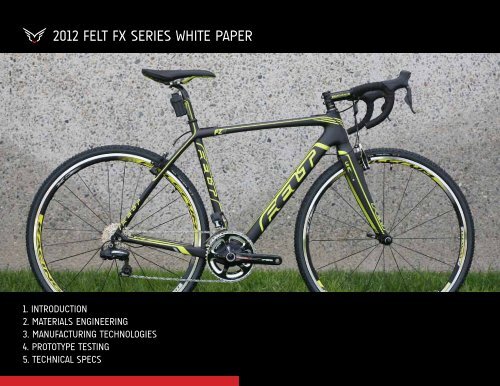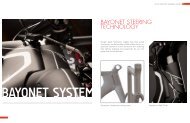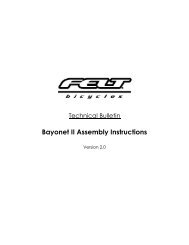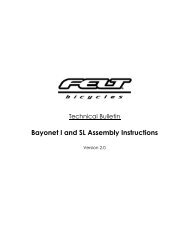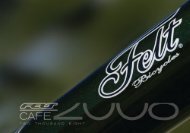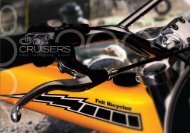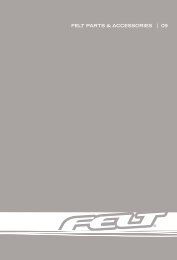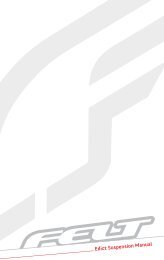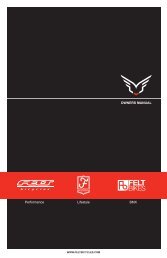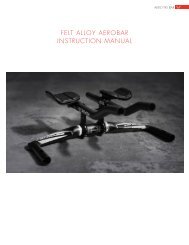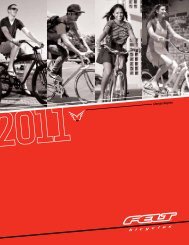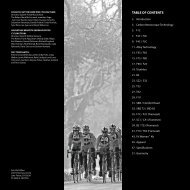2012 FELT FX SERIES WHITE PAPER - Felt Bicycles
2012 FELT FX SERIES WHITE PAPER - Felt Bicycles
2012 FELT FX SERIES WHITE PAPER - Felt Bicycles
Create successful ePaper yourself
Turn your PDF publications into a flip-book with our unique Google optimized e-Paper software.
<strong>2012</strong> <strong>FELT</strong> <strong>FX</strong> <strong>SERIES</strong> <strong>WHITE</strong> <strong>PAPER</strong>1. INTRODUCTION2. MATERIALS ENGINEERING3. MANUFACTURING TECHNOLOGIES4. PROTOTYPE TESTING5. TECHNICAL SPECS
INTRODUCTION<strong>Felt</strong>’s first-ever carbon-fiber cyclocross bike makes its debut with the <strong>2012</strong> lineup,but the roots of the new <strong>FX</strong> Series go back several years. It began with the developmentof <strong>Felt</strong>’s groundbreaking 2011 F Series carbon-fiber road bikes.Shortly after the F was unveiled at the 2010 Tour de France—following a three-yearphase of research and development—<strong>Felt</strong> engineers turned their attention to cyclocross.What elements of the F bike could be applied toward the development ofan all-new, pro-level cyclocross bike? That question sparked the genesis of the <strong>FX</strong>project.From the very start, <strong>Felt</strong> has always been driven by competition, partnering with theworld’s best athletes in all disciplines of the sport. Its most important innovations—bikes like the F Series road bike and DA time trial/triathlon bike—have been collaborativeefforts combining athletes, engineers and product developers, working togetherto create cutting-edge race technology. To produce its new carbon-fiber cyclocrossbike, <strong>Felt</strong> followed its usual recipe for success.Part of the <strong>FX</strong> bike’s story can be told by its stats: Its weight, about 1050 grams for a56cm frameset, 350 grams lighter than <strong>Felt</strong>’s previous top-of-the-line offering. The <strong>FX</strong>is the first <strong>Felt</strong> cyclocross bike to benefit from the advanced engineering, materialsand manufacturing processes of <strong>Felt</strong>’s latest-generation road bikes. It blends <strong>Felt</strong>’snewest road frame technologies with cyclocross geometry, additional mud clearance,arcing seatstays and a flattened top tube underside for more comfortable shouldering.And for serious cyclocross racers like Ryan Trebon, a former U.S. National Championsponsored by <strong>Felt</strong>, <strong>FX</strong> frames are optimized for Shimano Di2 electronic shifting.DESCENDED FROM THE F <strong>SERIES</strong>“For the most part, the <strong>FX</strong> is a continuation of the F bike story,” says <strong>Felt</strong> engineer TyBuckenberger. “Everything we learned while engineering, developing and building theF bike, we applied to the <strong>FX</strong>.”It’s easy to see from its appearance that the <strong>FX</strong> is related to its F Series road-racingcousin. “Based on what we learned and accomplished with the F bike, 80 or 90percent of our research as far as engineering and materials had been completedbefore we started to design the <strong>FX</strong>,” explains Buckenberger. “So when youlook at the F and <strong>FX</strong> together, you can definitely tell they’re related.”Beyond the carbon fiber materials, similarities between the F and the <strong>FX</strong>can be seen in the use of the ControlTaper head tube, which uses 1-1/8” topbearings and 1-1/2” bottom bearings for improved cornering, descending andsprinting—all critical components of cyclocross. The <strong>FX</strong> also borrows the BB30bottom bracket shell design with an oversized junction of the down tube, seattube and chainstays for maximum pedaling stiffness.With these technologies, engineers knew they could attain significant gainsover <strong>Felt</strong>’s previous-generation cyclocross bikes. So it was really a matter oroptimizing the new frame for cyclocross and giving it that ride quality thatdefines a <strong>Felt</strong> race bike. It was also about developing the perfect blend ofmaterials: light and stiff, but also durable.Like all new development projects at <strong>Felt</strong>, this one began with a comprehensiveanalysis phase. The recently completed road bike project had armed <strong>Felt</strong> engineerswith data from two facilities—<strong>Felt</strong>’s engineering/product developmentheadquarters in Irvine, California, and its manufacturing facility in Asia. Thosenumbers offered a starting point to understanding where the most significantimprovements could come in terms of reducing weight and increasing stiffnessand strength.Once the analysis phase was completed and the target goals were established,engineers knew exactly which traits would be borrowed from the F Seriesframes, and how the existing road technology could be tweaked for cyclocrossoptimization.
MATERIALS ENGINEERINGData obtained from FEA and ride testing led <strong>Felt</strong> engineers to determine that thecarbon fiber tube shapes of the existing F Series frames were close to optimal fora race-oriented cyclocross bike. Adhering to the “form follows function” philosophy,engineers shirked the idea of redesigning frame shapes strictly for design aesthetics.Instead, they made a few small adjustments to frame geometry, reshaped theunderside of the top tube for comfort and smooth transfers when shouldering thebike over barriers, and, perhaps most importantly, focused on perfecting the blend ofcarbon fiber materials.Engineering and manufacturing high-performance carbon fiber frames is a more complicatedprocess than working with steel, aluminum or titanium frames. There’s muchmore to it than simply selecting a high-grade material, creating a mold, and cookingup framesets. The <strong>FX</strong>’s combined goals of light weight, stiff and lively ride quality, andreinforced durability made the materials engineering process critical.Targetting those stated goals, <strong>Felt</strong> settled on its UHC Performance carbon fibermaterial. Raw carbon fiber comes with different levels of modulus (60T, 40T, 30T, forexample), but as the name Ultra Hybrid Carbon (UHC) implies, <strong>FX</strong> frames don’t consistof just one type of material. It’s a proprietary blend that’s custom made to optimizethe unique advantages of the different grades of carbon fiber. For example, stiffercarbon fiber plies may be used in areas of peak stress such as the bottom bracketshell and down tube while higher-strength carbon fiber plies are used in areas thatare susceptible to impact.“It was pretty clear to us that UHC Performance would be the optimal material for a’cross bike because it’s less brittle than some of the really lightweight carbon fiber,”says Buckenberger. “It’s still stiff, but it’s also really strong and holds up to impacts—which is key for a cyclocross bike.”
MANUFACTURING TECHNOLOGIESSelecting the carbon fiber material is just part of the engineering process. Manufacturingalso plays a significant role in how the bike performs. To meet its goals for Process. Custom-designed polyurethane inserts are placed inside the tubes duringbut <strong>Felt</strong> takes it a few steps further with its InsideOut Internally Optimized Moldingweight, stiffness and strength, <strong>Felt</strong> turned to some established construction techniques.The first is Modular Monocoque Construction, in which individual sections eliminate any excess material inside the carbon fiber tubing. The benefit, besidesthe molding process. They fit snugly against the shapes of the tubes, and this helpsof the frameset are molded and then joined together. For each section, carbon fiber having nice clean material surfaces inside the tubes, is obvious: Less material meansplies are strategically laid onto specially shaped internal molds. The lay-up is completedby hand, and the material is placed into a symmetrically split CNC-machinedless weight.mold (think waffle iron). The mold halves are then closed and locked. A preciseWhen the heating process is complete, the mold is opened up and the cured monocoquesection is removed. The sections are then joined together using a specialamount of pressure and heat is applied, and the bladder pushes the carbon fiberfirmly against the mold. Data obtained from FEA and ride testing led <strong>Felt</strong> engineers to determine co-molding that the process. They are bonded and then wrapped. The result, effectively, is acarbon fiber tube shapes of the existing F Series frames were close perfect to optimal frame for every time—inside and out.The above process is pretty a race-oriented standard with cyclocross most high-performance bike. Adhering to carbon the “form fiber follows bikes, function” philosophy,engineers shirked the idea of redesigning frame shapes strictly for design aesthetics.Instead, they made a few small adjustments to frame geometry, reshaped theunderside of the top tube for comfort and smooth transfers when shouldering thebike over barriers, and, perhaps most importantly, focused on perfecting the blend ofcarbon fiber materials.InsideOut technology withEngineering and manufacturing high-performance polyurethane carbon fiber frames inserts is a more helps complicatedprocess than working with steel, aluminum eliminate or titanium excess frames. material There’s muchbuild-up inside the frame andmore to it than simply selecting a high-grade material, creating a mold, and cookingreduces overall weight.up framesets. The <strong>FX</strong>’s combined goals of light weight, stiff and lively ride quality,and reinforced durability made the materials engineering process critical.Without InsideOut technology thereis excess material build-up insidethe frame.
PROTOTYPE TESTINGDeveloping a cyclocross frameset that weighs a little over 1000 grams and is strongenough to withstand the punishment of racing was a challenge—but only part of thechallenge. As <strong>Felt</strong> engineers often repeat, it’s the feel of a <strong>Felt</strong> bike that sets it apart.The final phase of development is prototyping.“We always spend a lot of time going through layup schedules, making small changesto find the perfect balance of materials that give it that magic feel bikes get wheneverything is just right,” Soucek says.During prototyping, a series of frames is produced, then ridden hard under real-worldconditions. This is the time when the lay-up schedule gets fine-tuned. The productionof each frame requires a huge amount of handwork that affects the way thebike rides. Adding or removing material from different areas of the frame goes a longway toward determining the bike’s weight, stiffness and strength. Feedback fromengineers and athletes during the prototype phase leads to small adjustments in thelay-up schedule that ultimately determine how the bike performs.
TECHNICAL SPECSUHC PerformanceThe material used to construct the <strong>Felt</strong> <strong>FX</strong> frame is eight times stronger than 3/2.5 titanium, more than three timesstiffer than 6061 aluminum and less than one-fourth the density of steel. And it can be formed into a wide varietyof shapes and exhibits nearly infinite fatigue life. Just a few years ago, the same technology was used for <strong>Felt</strong>’stop-of-the-line F1 SL road frameset.InsideOutThis “Internally Optimized” molding process completely eliminates excess material, and therefore weight, on theinside of the frame tubes and junctions. Placing polyurethane bladders inside the frames during the molding process—especiallyat the bottom bracket and head tube areas—and then applying a precise amount of pressure andheat, results in perfectly formed tubes, inside and out.CONTROLTaperThe F1 SL’s tapered head tube increases front-end stiffness and steering precision without adding weight to theframeset. Using 1-1/8” top bearings and 1-1/4” bottom bearings, ControlTaper significantly improves the bike’s handlingcharacteristics and adds an unmatched level of control for cornering, descending and sprinting.BB30 Bottom BracketThe oversized junction of the F1 SL’s down tube, seat tube and chainstays provides increased stiffness where it’sneeded most. The BB30 bottom bracket shell allows bearings to fit directly into the shell, without cups, to eliminateextra weight. It’s lighter, stiffer and capable of accepting just about every high-performance bottom bracketon the market.Optimized for CyclocrossThe <strong>FX</strong> frame is designed specifically for cyclocross competition. It has added tire clearance for muddy conditions,a top tube with a flattened underside or easier shouldering, and two water bottle bosses. The frame is alsodesigned with cable routing that’s optimized for Shimano Di2 or mechanical shifting.
<strong>2012</strong> <strong>FX</strong> <strong>SERIES</strong> TECHNICAL SPECSGEOMETRYFrame material: UHC Performance carbon fiberSize47505355576063*Frame details: Modular Monocoque Construction; Di2 optimized internal cable routing;BB30 bottom bracketFork: ControlTaperFork material: UHC Performance carbon fiberFork details: Modular Monocoque construction; carbon fiber blades, dropouts, crownand external steererSizes: 48, 51, 54, 56, 58, 61, 63 (F1X Frameset Only)HASATT horizTT C-CHead TubeST C-TST C-CBB Drop71755104951104704106571.574.5525510120500440657273.5540525130530470657273.556054315055049065727358058317057051065727360549019560054065737361560320063057065CS430430430430430430430Front Center583584585605620646645Wheelbase1005100510071027104210681067Rake50454545454545Standover726751779796814843864Fork length393393393393393393393Lower HS Stack1111111Reach368357377391400414420Stack525538549568587607618*63cm available as F1X Frameset Only


